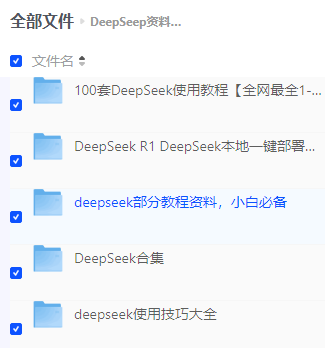Cookie&Session
Web 开发会话技术
- Web 开发会话技术
-
- 会话的两种技术
-
- Cookie
-
- 读取Cookie数据
- 创建Cookie实例
- 修改Cookie值
- cookie 生命周期
- cookie 有效路径
- Session
-
- 基本介绍
- 常用方法
- 原理示意图
- 操作代码示例
- session 生命周期
- 经典案例
大家好呀,我是小笙,我和大家分享下我学习Javaweb的笔记
Web 开发会话技术
什么是会话?
会话可简单理解为:用户开一个浏览器,点击多个超链接,访问服务器多个 web 资源,然后关闭浏览器,整个过程称之为一个会话
会话的两种技术
Cookie
概念:Cookie 是服务器在客户端保存用户的信息,比如登录名,浏览历史等, 就可以以 cookie 方式保存
cookie框架图
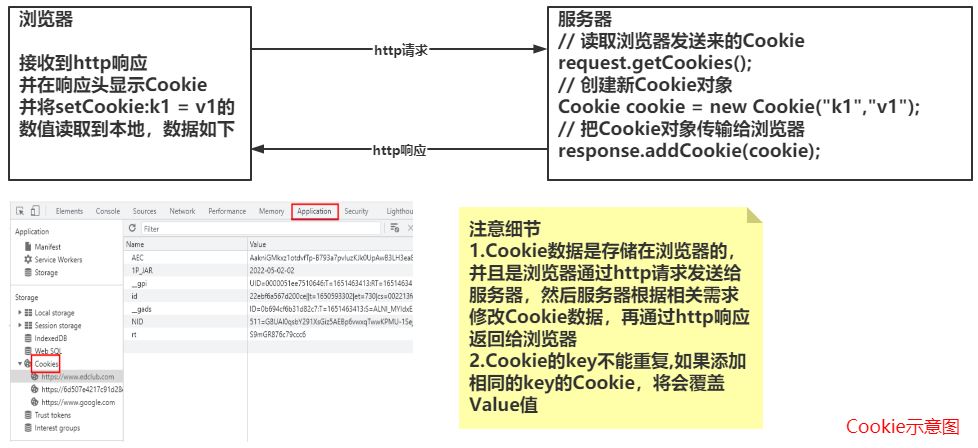
Cookie的作用
- 保存上次登录时间等信息
- 保存用户名,密码, 在一定时间不用重新登录
- 网站的个性化,比如定制网站的服务,内容
读取Cookie数据
-
浏览器端创建email=1079936135qq.com的数据
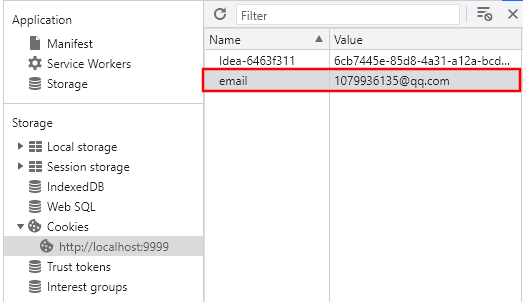
-
浏览器向服务器传输Cookie数据
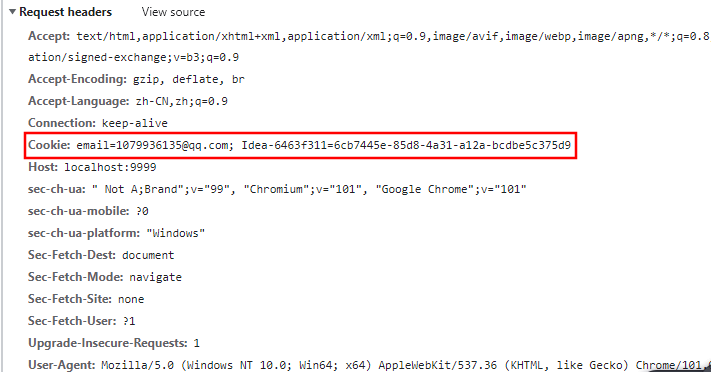
-
服务器读取到Cookie数据
protected void doGet(HttpServletRequest request, HttpServletResponse response) throws ServletException, IOException { Cookie[] cookies = request.getCookies(); if(cookies != null && cookies.length != 0){ for (Cookie coke : cookies) { // cookieName: email cookieValue1079936135 // cookieName: Idea-6463f311 cookieValue6cb7445e-85d8-4a31-a12a-bcdbe5c375d9 // 如果读取到中文名字 // 可以通过URLDecoder.decode(coke.getName(),"utf-8")解码 System.out.println("cookieName: " + coke.getName() + " cookieValue" + coke.getValue()); } }}
创建Cookie实例
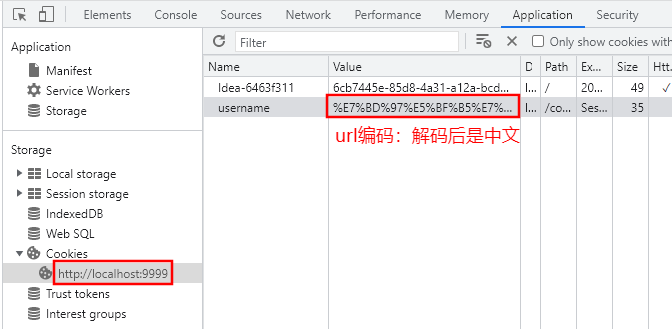
protected void doGet(HttpServletRequest request, HttpServletResponse response) throws ServletException, IOException { System.out.println("cookie被调用"); // 创建Cookie对象 // 解决不能存储中文的原因,需要进行url编码 String data = URLEncoder.encode("罗念笙","UTF-8"); Cookie cookie = new Cookie("username",data); //将Cookie发送给浏览器并保存 response.addCookie(cookie); response.setContentType("text/html;charset=utf-8"); PrintWriter writer = response.getWriter(); writer.write("Cookie创建成功!
"); writer.flush(); writer.close();}修改Cookie值

protected void doGet(HttpServletRequest request, HttpServletResponse response) throws ServletException, IOException { Cookie[] cookies = request.getCookies(); String cookieName = "email"; Cookie cookie = CookieUtils.nameToGetCookie(cookieName, cookies); CookieUtils.IterCookie(cookies); if(cookie == null){ System.out.println("没有该Cookie"); }else{ cookie.setValue("10799361@qq.com"); CookieUtils.IterCookie(cookies); response.addCookie(cookie); }}// 工具类public class CookieUtils { / * 通过CookieName来获取对应的Cookie */ public static Cookie nameToGetCookie(String cookieName,Cookie[] cookies){ if(cookieName != null && !cookieName.equals("") && cookies != null && cookies.length != 0){ for (Cookie cookie : cookies) { if(cookie.getName().equals(cookieName)){ return cookie; } } } return null; } / * 遍历Cookie,显示Cookie的name-value */ public static void IterCookie(Cookie[] cookies){ System.out.println(); if(cookies != null && cookies.length != 0){ for (Cookie cookie : cookies) { System.out.println("cookieName: " + cookie.getName() + " cookieValue: " + cookie.getValue()); } } System.out.println(); }}cookie 生命周期
常用方法
// 正数,表示在指定的秒数后过期// 负数,表示浏览器关闭 Cookie 就会被删除(默认值是-1)// 0,表示马上删除 Cookie (可以用来删除Cookie)setMaxAge()代码示例
protected void doGet(HttpServletRequest request, HttpServletResponse response) throws ServletException, IOException { // 创建一个新的Cookie对象 Cookie cookie = new Cookie("age","18"); // 设置Cookie的生命周期 20s cookie.setMaxAge(20); // 返回给浏览器存储20s response.addCookie(cookie);}cookie 有效路径
Cookie 的 path 属性可以有效的过滤哪些 Cookie 可以发送给服务器,哪些不发。 path 属性是通过请求的地址来进行有效的过滤
// 举例说明 (默认setPath:/工程路径 )cookie1.setPath = /工程路径 cookie2.setPath = /工程路径/aaa // url请求地址: http://ip:端口/工程路径/资源 cookie1 会发给服务器 cookie2 不会发给服务器 // url请求地址: http://ip:端口/工程路径/aaa/资源 cookie1 会发给服务器 cookie2 会发给服务器Cookie 注意事项和细节
-
一个 Cookie 只能标识一种信息,它至少含有一个标识该信息的名称(NAME)和设置值 (VALUE)
-
一个 WEB 站点可以给一个浏览器发送多个 Cookie,一个浏览器也可以存储多个 WEB 站点提供的 Cookie
-
Cookie 的总数量没有限制,但是每个域名的 Cookie 数量和每个 Cookie的大小是有限制的 (不同的浏览器限制不同) , Cookie 不适合存放数据量大的信息
-
注意中文存入cookie的时候需要编码和解码
// url编码String data = URLEncoder.encode("想要存入的中文","UTF-8");Cookie cookie = new Cookie("username",data);//url解码URLDecoder.decode(cookie数据,"utf-8");
Session
基本介绍
概念:Session 是服务器端技术,服务器在运行时为每一个用户的浏览器创建一个其独享的 session 对象/集合,由于 session 为各个用户浏览器独享,所以用户在访问服务器的不同页面时,可以从各自 的 session 中读取/添加数据
session 对象默认存在时间为 30min
<session-config> <session-timeout>30</session-timeout></session-config>Session的作用
- 将数据放入到 Session 中,供用户在访问不同页面时,实现跨页面访问数据
- 保存登录用户的信息
- 防止用户非法登录到某个页面等等
session 存储结构示意图
| 名字(key) | 值(value) |
|---|---|
| String类型 | Object类型 |
常用方法
// 1.创建和获取 Session// 第1次调用是创建 Session 会话, 之后调用是获取创建好的 Session 对象 HttpSession hs=request.getSession(); // 2.向 session 添加属性 hs.setAttribute(String name,Object val); // 3.从 session 得到某个属性 Object obj=hs.getAttribute(String name);// 4.从 session 删除调某个属性: hs.removeAttribute(String name); // 5.判断是不是刚创建出来的 Sessionhs.isNew(); // 6.每个Session都有1个唯一标识Id值,通过getId()得到Session的会话id值(JSESSIONID)原理示意图
JSESSIONID
用于服务器来标识不同的会话,不同的会话,服务器会对应创建不同的JSESSIONID

框架图
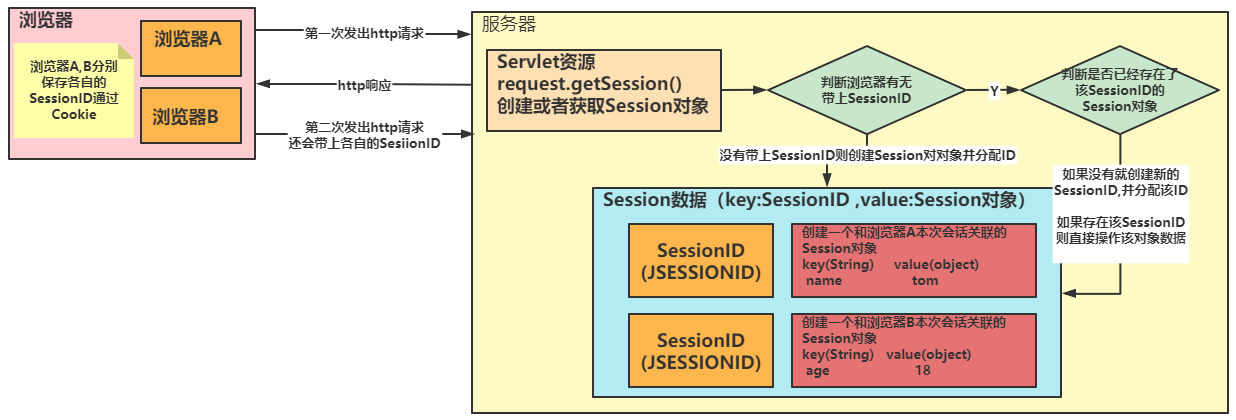
操作代码示例
设置属性
protected void doGet(HttpServletRequest request, HttpServletResponse response) throws ServletException, IOException { response.setContentType("text/html;charset=utf-8"); PrintWriter writer = response.getWriter(); HttpSession session = request.getSession(); session.setAttribute("id","1234956789"); System.out.println("属性设置完成"); writer.flush(); writer.close();}读取属性
protected void doGet(HttpServletRequest request, HttpServletResponse response) throws ServletException, IOException { response.setContentType("text/html;charset=utf-8"); PrintWriter writer = response.getWriter(); HttpSession session = request.getSession(); Object s = session.getAttribute("id"); if(s != null){ System.out.println((String)s); }else{ System.out.println("没有该属性"); } writer.flush(); writer.close();}session 生命周期
Session 的生命周期指的是 :客户端/浏览器两次请求最大间隔时长,而不是累积时长。 即当客户端访问了自己的 session,session 的生命周期将从 0 开始重新计算。(同一个会话两次请求之间的间隔时间)
底层: Tomcat 用一个线程来轮询会话状态,如果某个会话的空闲时间超过设定的最大值, 则将该会话销毁
// 设置 Session 的超时时间(以秒为单位), 超过指定的时长,Session 就会被销毁// 1.值为正数的时候,设定 Session 的超时时长// 2.负数表示永不超时// 3.如果没有调用 setMaxInactiveInterval() 来指定Session的生命时长,Tomcat 会以Session默认时长为准,Session 默认的超时为30分钟,可以在tomcat的web.xml设置;注意Cookie是累计时长,时间一到就会销毁public void setMaxInactiveInterval(int interval)// 获取 Session 的超时时间public int getMaxInactiveInterval()// 让当前 Session 会话立即无效public void invalidate()经典案例
防止非法进入管理页面
- login.html表单提交给LoginCheckServlet.java
- 如果验证成功(用户名不为空,密码为 666666,),则进入管理页面 ManageServelt.java,如果验证不成功,跳转到error.html页面
- 如果用户直接访问 ManageServet.java , 重定向到到 login.html
<!DOCTYPE html><html lang="en"> <head> <meta charset="UTF-8"> <title>用户登录</title></head> <body><h1>用户登录</h1> <form action="/session/loginCheck" method="post"> 用户名:<input type="text" name="username"/><br/><br/> 密 码:<input type="password" name="password"><br><br/> <input type="submit" value="登录"> </form> </body></html><!DOCTYPE html><html lang="en"><head> <meta charset="UTF-8"> <title>Title</title></head><body> <h1>登录失败</h1> <a href="login.html" style="text-decoration: none">点击返回重新登录</a></body></html>// LoginCheckServlet.javaprotected void doGet(HttpServletRequest request, HttpServletResponse response) throws ServletException, IOException { String username = request.getParameter("username"); String password = request.getParameter("password"); if(username != null && password != null){ if(!"".equals(username) && "666666".equals(password)){ HttpSession session = request.getSession(); session.setAttribute("username",username); request.getRequestDispatcher("/manageServlet").forward(request,response); }else{ request.getRequestDispatcher("/error.html").forward(request,response); } }else{ response.sendRedirect("/login.html"); }}// ManageServlet.javaprotected void doGet(HttpServletRequest request, HttpServletResponse response) throws ServletException, IOException { HttpSession session = request.getSession(); Object username = session.getAttribute("username"); if(username != null){ response.setContentType("text/html;charset=utf-8"); PrintWriter writer = response.getWriter(); writer.println("用户管理页面
"); writer.println("欢迎你,管理员: " + (String)username); writer.flush(); writer.close(); }else{ response.sendRedirect("/session/login.html"); }}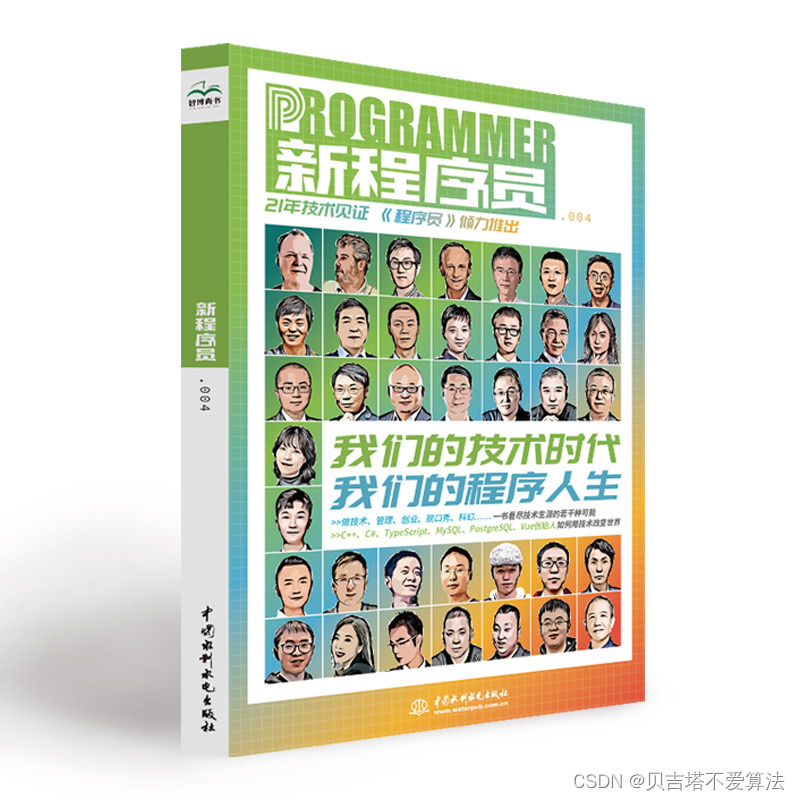 开发者涨薪指南
开发者涨薪指南 ![]() 48位大咖的思考法则、工作方式、逻辑体系
48位大咖的思考法则、工作方式、逻辑体系

